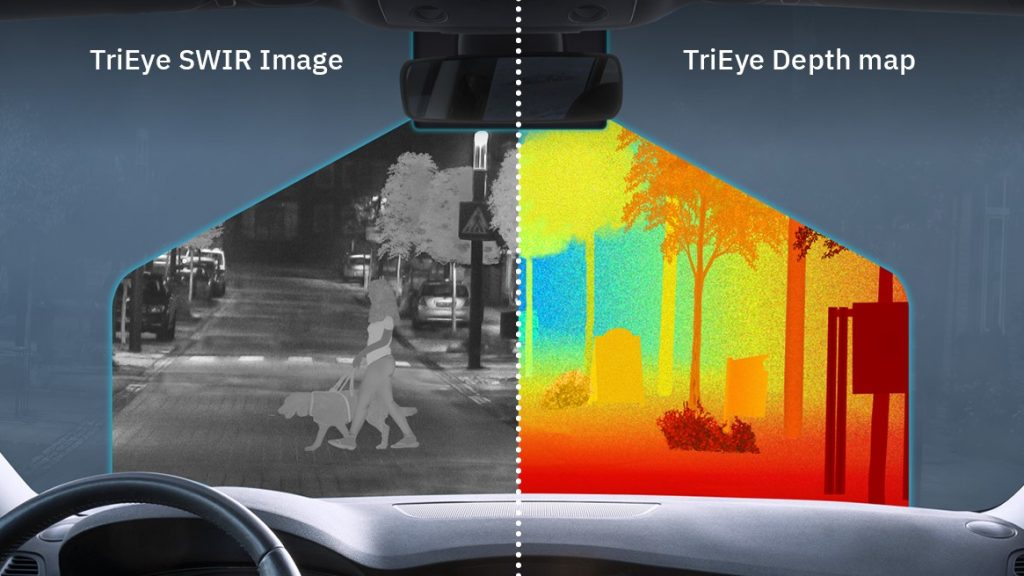
Tel Aviv, Israel-based startup TriEye has launched its SEDAR (Spectrum Enhanced Detection and Ranging) platform designed to transform sensing in the automotive sector—as well as in emerging markets in robotics, commercial vehicle applications, consumer, and mobile devices. The SEDAR platform leverages SWIR (short-wave infrared) technology to offer 2D imaging and 3D determinative depth sensing at a fraction of the cost of other sensor systems such as lidar in automotive.
The company says that the SEDAR platform delivers a step-change in the level and quality of the information provided to enable “entities” including vehicles, robots, and mobile devices to understand their surroundings in any condition and lighting.
“The TriEye SEDAR platform is poised to transform the sensing industry with its unique combination of attributes,” said Avi Bakal, TriEye CEO and Co-Founder. “Developed through a decade of research at Hebrew University in Jerusalem, SEDAR combines a SWIR image sensor and laser illuminator on a single platform, which delivers unmatched high spatial resolution long-range imaging and depth sensing in all lighting and weather conditions. Smaller in size, higher in resolution, and easier to integrate than other sensor technologies, SEDAR provides an entirely new sensing modality.”
SEDAR is built on TriEye’s CMOS (complementary metal-oxide semiconductor)-based HD SWIR sensor. The automotive-grade off-the-shelf solution is said to significantly enhance safety and operating performance in ADAS (advanced driver assistance systems) and AV (autonomous vehicle) applications. It can be integrated with existing ISP (image signal processor) and AI (artificial intelligence) algorithms, removing the barriers of training and the need to develop new object classification algorithms. The sensing solution is said to be unaffected by other illumination sources including sunlight and light from other devices and oncoming vehicles.
“By reducing the system cost compared with lidar by more than a factor of ten and providing a technology capable of enabling a vehicle to sense the world around it, monitor its environment, and react accordingly, within affordable reach of all automotive manufacturers, TriEye’s proprietary SEDAR system will democratize advanced road safety,” added Bakal.

Founded in 2017 by Bakal, CTO Prof. Uriel Levy, and VP of R&D Omer Kapach, TriEye is a fabless semiconductor company that lays claim to being the pioneer of the world’s first HD SWIR sensing solution, offering the unique capabilities of SWIR for mass-market applications. In 2019, the company completed a $19 million Series A funding round, led by Intel Capital, with the participation of Porsche Ventures and Grove Ventures, in addition to a collaboration with Porsche AG. In 2021, it raised a further $74 million in a new round led by M&G Investments and Varana Capital, with the participation of Samsung Ventures, Tawazun SDF, Deep Insight, Allied Group, and Discount Capital, along with existing investors including Marius Nacht.
TriEye’s development program has enabled SEDAR to operate at distances of more than 200 m, making it suitable for automotive applications. The company’s engineers have also been able to optimize the performance for other shorter-range applications with a wider field of view such as commercial, industrial, robotics, mobile, and consumer use cases.
“SEDAR provides a readymade bolt-on solution to deliver a step change for commercial vehicles operating in busy and potentially hazardous environments such as construction, agriculture, and mining,” Bakal said. “And the platform is equally eminently suited to enhancing the performance of consumer products such as vacuum and lawnmower robots and support smartphones and other head-mounted mobile devices in augmented- and virtual-reality applications.”
TriEye’s technology has gotten increasing interest in the mobility OEM space. In 2021, the company announced SWIR collaborations with Continental Engineering Services for driver monitoring systems and with Trimble for autonomous applications and remote material sensing. In 2022, it announced a collaboration with Tier 1 automotive supplier Hitachi Astemo to enhance ADAS capabilities for adverse weather and low-light conditions. In June at a Veoneer ride and drive event, TriEye offered a deep dive into its SWIR HD imaging and accurate ranging in all visibility conditions through one sensor system for ADAS and autonomous vehicles.
The SEDAR is based on two innovations: TriEye’s Raven HD CMOS-based SWIR sensor and TriEye’s UltraBlaze Eye-safe SWIR pulsed laser illumination source.
Raven is said to be the world’s first CMOS-based SWIR sensor. By solving fundamental constraints in manufacturing, TriEye’s unique sensor design provides high-resolution, low power consumption, a small form factor, and a 1000x price reduction compared to current InGaAs technology.
TriEye’s full-stack solution allows a machine-vision system to operate and deliver image data and other information under challenging visibility conditions by leveraging TriEye’s expertise in device physics, process design, electro-optics, and system engineering.
Key specs of the Raven sensor are a resolution of 1284 x 960 (h x w), a sensor spectrum of 0.4-1.6 µm, a pixel pitch of 7 µm, an imager size of 8.98 x 6.72 mm (h x v), and an iBGA package size of 13 x 13 mm (h x v), and a maximum capture rate of 120 fps.

